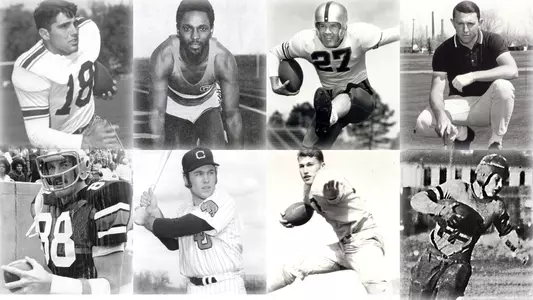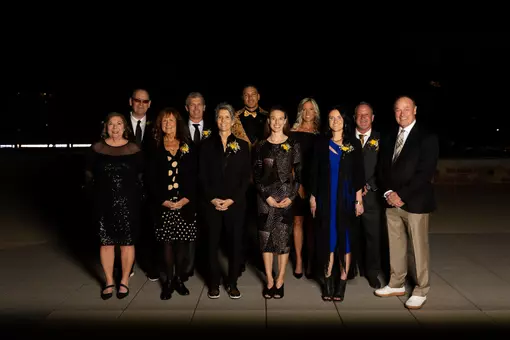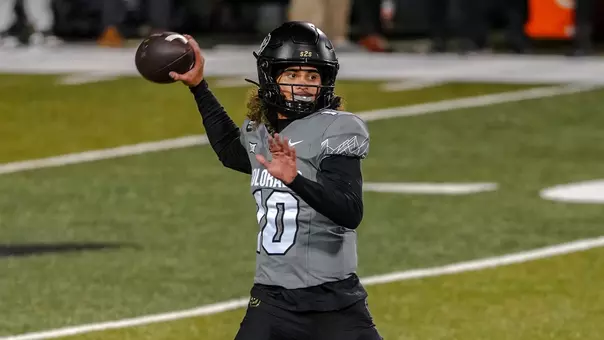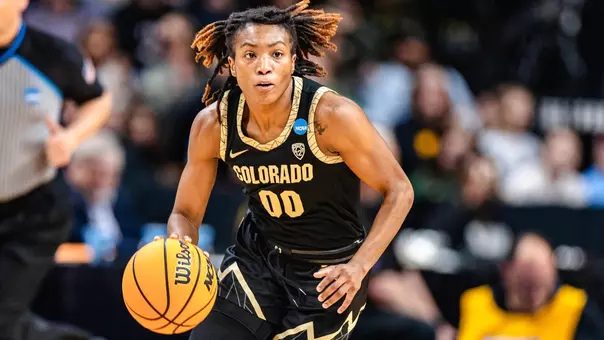Colorado University Athletics

Two-Sport Stars A Big Part Of Buffs History
May 17, 2017 | General, Alumni C Club, Neill Woelk
BOULDER — When Colorado football and track standout Isaiah Oliver recently made news by finishing fourth in the Pac-12 decathlon and just missing a chance to advance to the NCAAs, it sparked memories of other two-sport standouts in CU history.
There was a time when multi-sport stars were fairly commonplace on the college athletics landscape, and Colorado's history is sprinkled liberally with such standouts.
But two-sport athletes became more and more rare beginning in the mid- to late 1970s, when specialization — a year-round commitment to just one sport — began to be the norm. Now, most sports at the Division I level have rigorous offseason programs that make it much more difficult for athletes to participate in more than one sport in college. (The fact that CU dropped baseball in 1980 also reduced the opportunity for two-sport Buffs standouts.)
Women's varsity sports, meanwhile, weren't added until the mid-1970s at Colorado — and even then, the choices were limited for several years until the Buffs slowly began adding more sports. And, just as is the case with men's sports, a year-round commitment to one sport reduces the chance for multi-sport participants.
Still, there have been a handful of two-sport participants at CU over the last few decades
The most-common crossover is football and track, a crossover helped by the fact that football is played in the football and track contested in the spring. Along with Oliver, others who have participated in both in recent years include Matt Lepsis, Hugh Charles and Aaron Haigler. There have also been some basketball-football crossovers, including Brian Johnson, Alfred Williams and Rodell Guest
On the women's side, former Buff skier Linda Wikstrom (a 1999 NCAA champion) also played soccer for the Buffs for a season. Amber Metoyer played basketball and competed in the heptathlon for CU, and volleyball player Kelsey English high jumped for the track team. Doni Fischer played for CU's second women's basketball team and also went to the nationals in the discus, and basketball players Jill Harmon and Marilyn Usick also both played tennis.
Still, the instances when athletes are truly stars in two sports are becoming rare.
So, we've compiled a quick list of some of the more notable multi-sport athletes in CU history. By no means is it a comprehensive list, and neither is it a "ranking" of any kind (most are, however, members of the CU Athletic Hall of Fame).
Rather, it is more a reminder of the rich history and tradition of CU athletics. We will be writing more about CU's two-sport (and three) stars in the future, and would like to hear from readers who want to see other names added to the list.
In no particular order:
Byron "Whizzer" White: His history is well-known to most Buffs fans. A unanimous All-American running back and Heisman Trophy runner-up in 1937, White was a Rhodes Scholar winner and enjoyed several outstanding years in the NFL before becoming a decorated naval intelligence officer in World War II. He graduated from Yale Law School, and went on to become a deputy U.S. Attorney General before being named to the U.S. Supreme Court. What some CU fans don't remember is that White was also a standout baseball and basketball player at CU, playing for the Buffs basketball team that advanced to the finals of the NIT in 1938, one year before the first NCAA tournament.
Hale Irwin: The Boulder High star attended CU on a football scholarship and didn't disappoint, twice earning All-Big Eight honors as a defensive back (1965-66). But he also excelled in his "other" sport — golf. Irwin won the 1967 NCAA championship and proceeded to become one of the most successful pro golfers of his generation, producing a career that included three U.S. Open championships.
Carroll Hardy: One of the most prolific three-sport athletes in CU history, Hardy earned 10 letters in football, baseball and track while earning all-conference honors in baseball and football (1953-54). He averaged 6.87 yards per carry as a running back and twice hit better than .400 in baseball. He was drafted by the San Francisco 49ers, but after one year in the NFL he turned his attention to baseball and played eight years in the major leagues. He is also immortalized as the only player to pinch hit for Hall of Famers Ted Williams and Carl Yastrzemski, and he also pinch-hit for Roger Maris in his time in the majors.
Dave Logan: A standout football and basketball player at Colorado, Logan was drafted in both sports (he was also drafted in baseball out of high school). He was a Sporting News All-American wide receiver as a senior (1975), led the Buffs in receiving twice, and also averaged 14.1 points per game on the basketball floor. He chose to play football in the pros and went on to a standout career with the Cleveland Browns and also played one year for the Denver Broncos.
Frank Bernardi: A standout running back for the Buffs in the 1950s, he once ran for 152 yards and two touchdowns on just five carries in a 46-0 win over CSU. He played four seasons in the NFL and was also a member of the first Denver Broncos team in 1960. He was also a star baseball player at CU, leading the teams in home runs and RBI in 1954.
Bobby Anderson: An All-American running back, two-time All-Big Eight selection and member of the College Football Hall of Fame, Anderson's name is firmly entrenched in CU football annals as an all-time Buffs great. Anderson was also a standout catcher for the Buffs' baseball team.
John Stearns. Thanks to legendary CU sports information director Fred Casotti, Stearns earned the nickname "Bad Dude" at Colorado. Known as a fierce hitter, he was named an All-Big Eight defensive back in 1972 and he still owns the CU career record for interceptions with 16, leading to him being drafted by the Buffalo Bills in 1973. But Stearns made his mark professionally in baseball after he led the Big Eight in hitting in 1972 (.492) and was the NCAA home run champion in 1973 (15). Drafted by the New York Mets, he went on to become an All-Star catcher in the major leagues.
Cliff Branch. A star receiver and return specialist at CU, he was a first-team All-American as a senior in 1971. He set CU and NCAA records for career return touchdowns (six punts, two kickoffs), a CU record that still stands. A fourth-round pick of the Oakland Raiders, he won three Super Bowl rings, caught 67 touchdown passes and was a four-time All-Pro selection. Branch is also one of the best sprinters in CU track history, with an NCAA title in the 100 meters (1972 outdoors). His 10.0 time in the 100 is still a CU record, and he also ran on a 4x100 relay that was among the best in the world in that era.
Don Branby. One of the last three-sport lettermen in Colorado history, he was an AP All-American in football in 1952, when he set a CU record with seven fumble recoveries and nine takeaways. He went on to become a seventh-round draft pick of the New York Giants and became a coach after his playing days. He also lettered in basketball and led the Buffs in free throw percentage in 1951-52, and played first base, third base and outfield for Colorado.
Lee Willard. The man for whom the Lee Willard Award is named (given annually to the top freshman on the CU football team), he is the only athlete in CU history to earn 16 letters — lettering every year in football, basketball, baseball and track from 1918-22. He was inducted into the Colorado Sports Hall of Fame in 1991.
Again, this is only a partial list of the all-time two- and three-sport stars at Colorado. Hundreds of athletes excelled in more than one sport and dozens and dozens more played at least briefly in more than one. We would love to hear your suggestions and comments as we continue to remember Buffs who were all-around stars.
Contact: Neill.Woelk@Colorado.edu





